Tree Talk: Oak
Yes friends, it's time for your sporadic dose of Druidy goodness - tree talk! For our second installment, we're going to discuss oak trees. :)
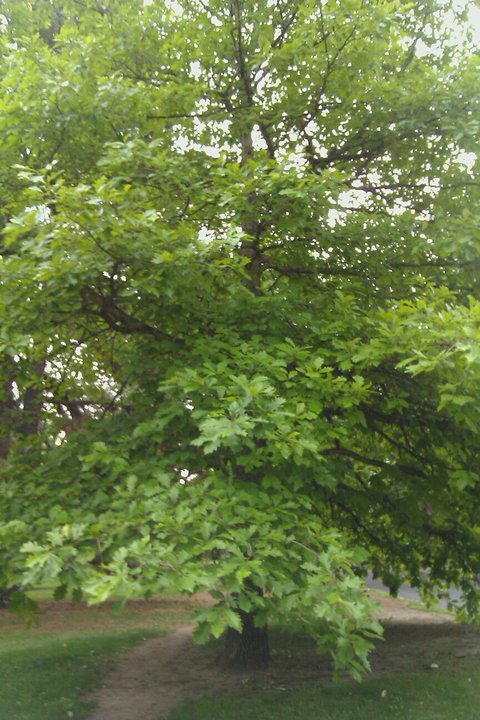
Past editions:
Tree Talk: Elm
Oak Trees Identification
- Their leaves are lobed, and can be either pointy (red oaks) or rounded (white oaks).
red oak, from https://treekey.phillytreemap.org/species/37.html

white oak, from http://forestry.sfasu.edu/faculty/stovall/dendrology/index.php/fact-sheets-sp-916/photographs/138-quercus-alba-white-oak
This site (https://www.gardenguides.com/115435-identify-oak-trees-leaf-shape.html) has some interesting info about counting the number of lobes on the leaf to determine exactly which species it is (I actually didn't know that before, so I'm going to write that down and test it out in the field myself!)
Can be as small as 3 feet high (California Scrub Oak, 3'-10' height), and as tall as 100 feet (Canyon Live Oak, 20'-100'; Valley Oak, 40'-100').
Produce acorns of varying shapes and sizes, with differently textured caps. Some are edible, but contain varying levels of tannins which make them bitter - the fewer tannins, the sweeter the acorn (https://honest-food.net/how-to-eat-acorns/).
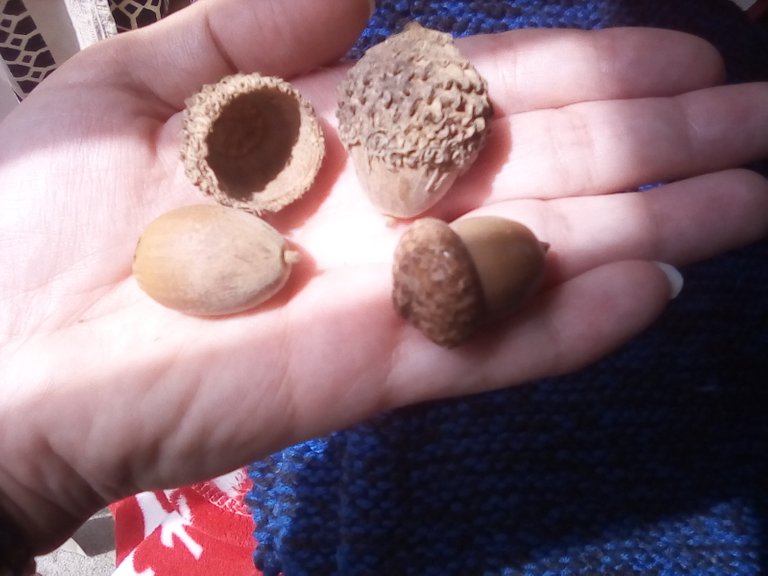
two different kinds of acorns, one with the cap off
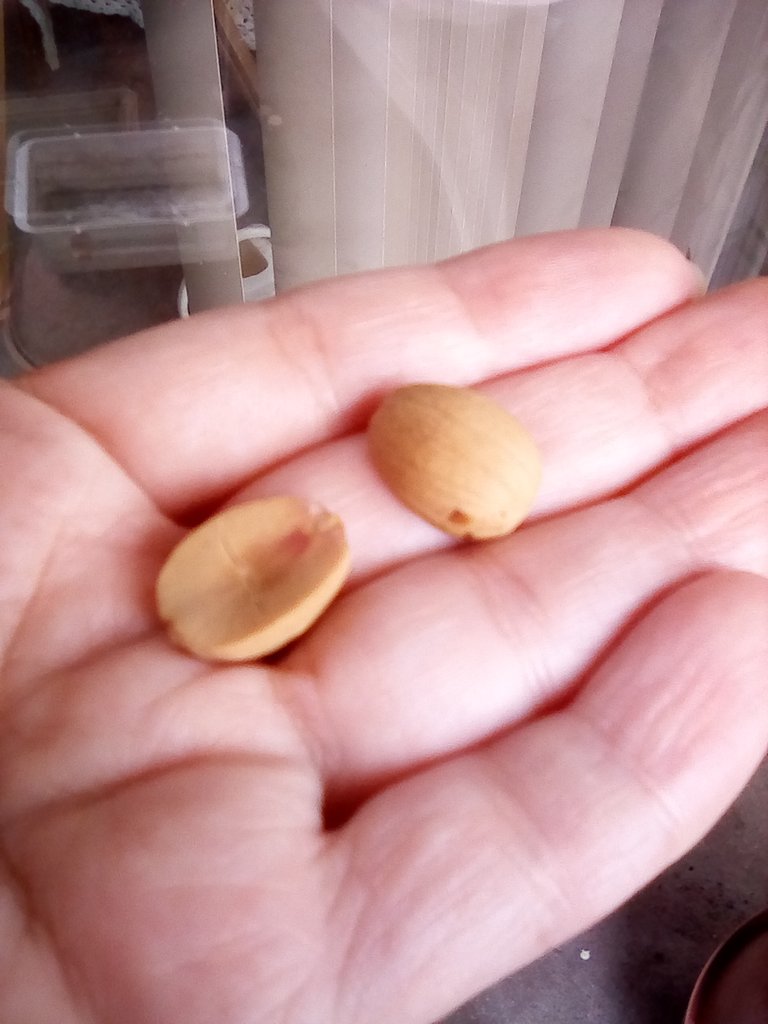
the inside nut of an acorn
- Can be deciduous (their leaves fall in autumn) or evergreen ("live oaks").
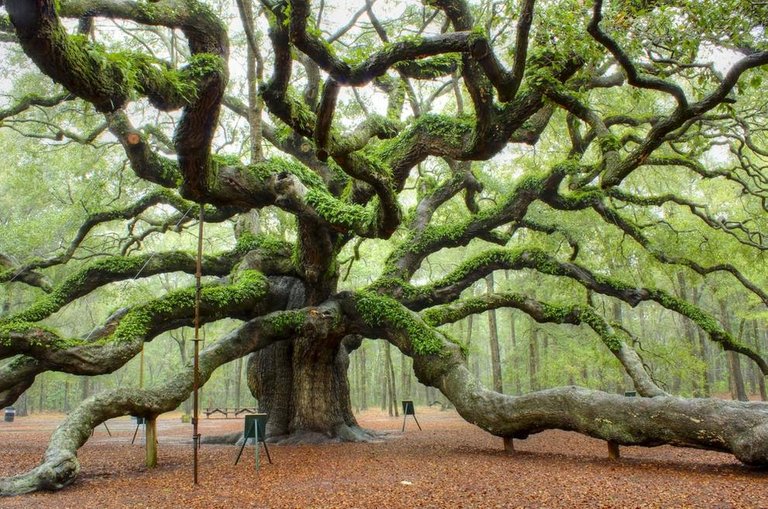
the Angel Oak Tree in South Carolina, a southern live oak; image from https://beautyplanet360.blogspot.com/2014/03/1-most-famous-and-beautiful-trees-of-earth.html
- English Oaks (and some other species) grow both male and female flowers/catkins:
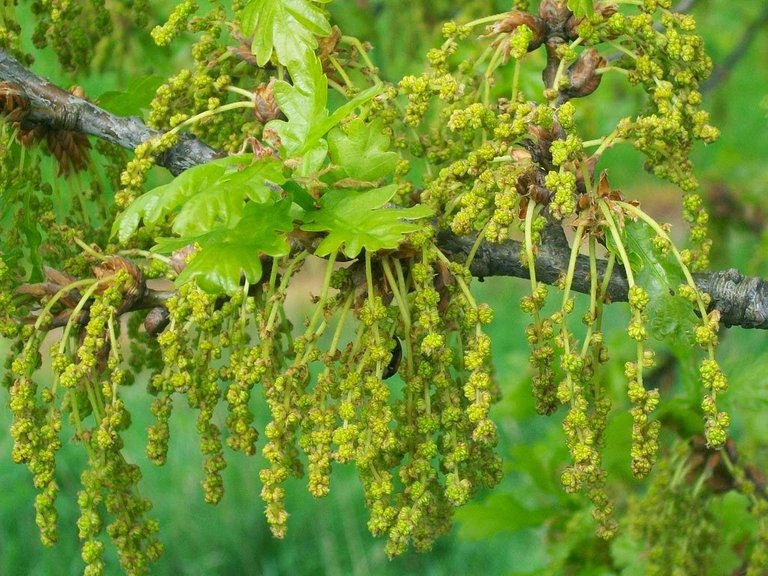
from https://treesplanet.blogspot.com/2014/05/quercus-robur-pedunculate-oak-english.html
Oak Trees Myths, Legends, and Customs
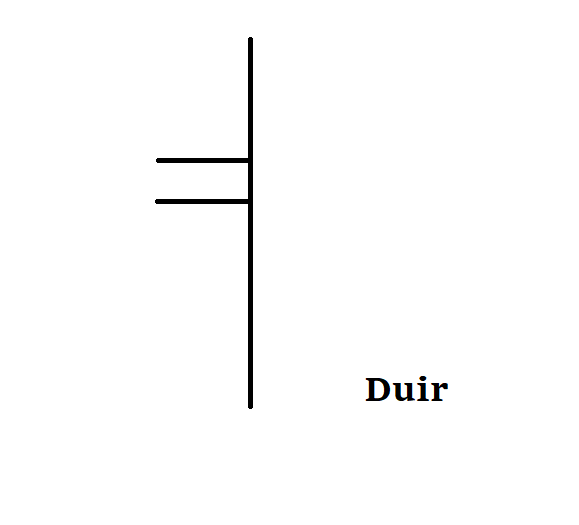
This is the ogham (Celtic alphabet) letter for oak, Duir, or sometimes Dair (which is where place names like Kildare and Derry in Ireland come from). The vertical line is not part of the letter per se; all ogham letters stem off a center line - it's the two horizontal lines on the left that are the letter itself.
What? You didn't know the Celts had a written language? They did, and you can see it on some standing stones, where the corner of the stone is the center line. But they're not grave markers, as you might think today. Most of them are place markers, like, "this is so-and-so's field," or road markers, like, "so-and-so city is this way, and so-and-so place is that way."
Oak trees are associated with druids, the high king or kingship in general, and the Dagda (a Celtic God, and the keeper of the Cauldron of Plenty) in Celtic culture. In Greece, there were oak tree spirits (Dryads), and the sacred oak grove at Dodona, which was sacred first to Diana and then to Zeus, was a place for oracles and prophecy. In the legend of Jason and the Argonauts, the Goddess Athene took a beam made from Zeus' oak at Dodona and fitted it into the prow of the ship; the beam would whisper to the Argonauts whenever danger threatened. In the bible, Abraham is supposed to have received heavenly visitors under an oak, Jacob buried the idols of Shechem under an oak, and Gideon saw the angel who told him how to free Israel under the Oak of Ophra.
The oak is associated with thunder Gods like Taranis (continental and British Celtic), Tuireann (Irish), Thor (Scandinavian), Thunor (Anglo-Saxon), and Zeus (Greek), which makes a lot of sense when you know that oak trees are struck by lightning more than any other species.
King Arthur's round table was supposed to have been made from one slice of a large oak, and Merlin's wand was the topmost branch of an oak tree. There is a town in Wales called Caerfyrddin, which means "Merlin's fortress," and there is a prophecy that when his oak fell, the town itself would fall. The tree credited as his was in Priory Street, and had deteriorated to a trunk reinforced with iron and concrete to keep it together, but then it was stolen! The town planted a new tree in a different location, but not where the original was, so as not to mess with the legend.
Oak Trees Growth, Habitat, and Disease
There are around 600+ species of oak. Some are deciduous and some are evergreen. They will grow in most any climate except the tropics, and can survive for centuries.
The English Oak is actually native to Europe, Northern Africa, and Western Asia - not just England.
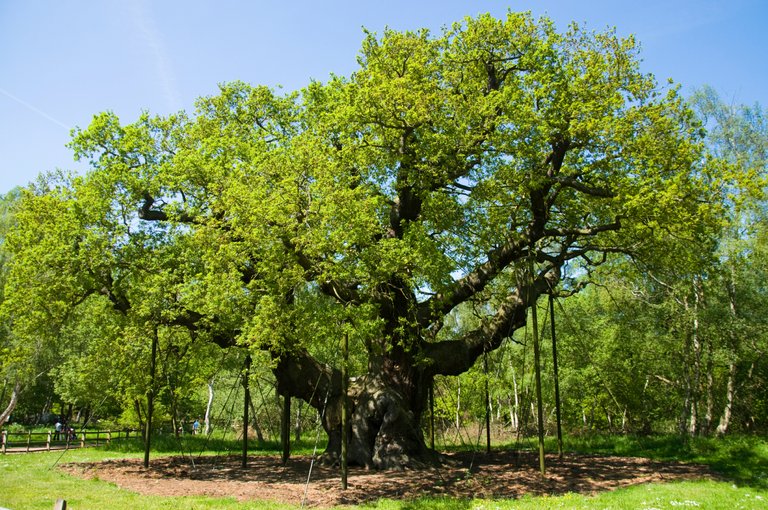
Major Oak - reputed to be the hideout for Robin Hood and his Merry Men, and upwards of 1000 years old. Can fit 34 children within its hollow trunk. Image from https://www.history.com/news/10-famous-trees-in-history
The top 5 fastest growing oak trees, according to https://dengarden.com/gardening/5-Great-Fast-Growing-Oak-Trees, are: California White Oak, Northern Red Oak, Pin Oak, Sawtooth Oak, and Water Oak.
Red oaks are more susceptible to oak wilt disease, which is caused by a fungus, than white oaks.
And that's it for another edition of Tree Talk!
Thanks for joining me as we explore the mysteries of oak trees! See you next time! :)
References:
National Audubon Society, Field Guide To Trees, Western Region (North America), by Elbert L. Little, Susan Rayfield, and Olivia Buehl
Form & Foliage, Guide To Shrubs & Trees, A Collection Of Garden Favorites, by Susin Leong & Tracy Loughlin
Tree Wisdom, The definitive guidebook to the myth, folklore and healing power of Trees, by Jacqueline Memory Paterson
Celtic Tree Mysteries, Secrets of the Ogham, by Steve Blamires
Plant a Tree for Free:
http://onetreeplanted.refr.cc/wrenpaasch
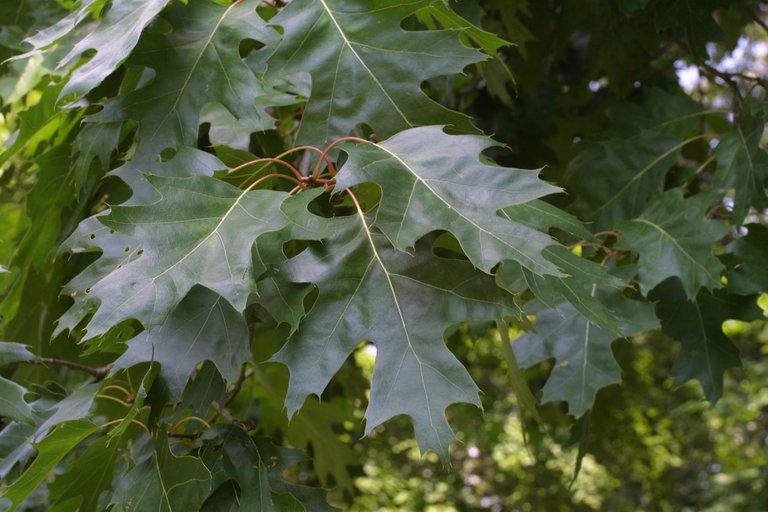

You forgot to mention oak is great firewood 😁 !tip
:P
Actually yeah there's a famous poem that's supposed to be advice from the faerie king about which woods to burn in your hearth, and oak is in there. :)
And thanks for the tip!
🎁 Hi @phoenixwren! You have received 0.1 STEEM tip from @davedickeyyall!
@davedickeyyall wrote lately about: #Themorningbowl With Miley Cyrus Feel free to follow @davedickeyyall if you like it :)
Sending tips with @tipU - how to guide :)
Hey, this is culture I need!
!trdo and Resteemed 🤗 for re-read it tomorrow morning... night! 😘
Congratulations @amico, you are successfuly trended the post that shared by @phoenixwren!
@phoenixwren got 6 TRDO & @amico got 4 TRDO!
"Call TRDO, Your Comment Worth Something!"
To view or trade TRDO go to steem-engine.com
Join TRDO Discord Channel or Join TRDO Web Site
Thank you for the Trendo! I can't send those yet, so have another !BEER
Goodnight! :)
Ehhehhehh !BEER 🍻 is !giphy good! 😜
// You can support giphy by using one of your witness votes on untersatz! //
To view or trade
BEERgo to steem-engine.com.Hey @phoenixwren, here is your
Do you already know our BEER CrowdfundingBEERtoken. Enjoy it!To view or trade
BEERgo to steem-engine.com.Hey @amico, here is your
Do you already know our BEER CrowdfundingBEERtoken. Enjoy it!Where would we be without the oak?
In a much sadder world. <3
Was expecting a microscope picture.
Oooh I should microscope photo some acorns and oak leaves...
Congratulations @phoenixwren! You have completed the following achievement on the Steem blockchain and have been rewarded with new badge(s) :
You can view your badges on your Steem Board and compare to others on the Steem Ranking
If you no longer want to receive notifications, reply to this comment with the word
STOPOak was commonly used in the frames of ships and wood railroad cars because of it's strength and flexability. Oak is said to have a strong masculine energy in describing it's magical properties.
What a cool post! Our signature oak is a white oak. Some years it has tons of acorns and the deer are in our yard after them. Other years, very few.
Oh yeah! I should have included this video about "masting" in the post! :D Thank you for the reminder!
This post has been voted on by the SteemSTEM curation team and voting trail. It is elligible for support from @curie.
If you appreciate the work we are doing, then consider supporting our witness stem.witness. Additional witness support to the curie witness would be appreciated as well.
For additional information please join us on the SteemSTEM discord and to get to know the rest of the community!
Please consider setting @steemstem as a beneficiary to your post to get a stronger support.
Please consider using the steemstem.io app to get a stronger support.
Thank you! Yay botany! :)
Love it !
Thanks! :)
That Angel Oak Tree is so amazing it almost looks alien. 👽
Great post, thanks for sharing!
Thanks for reading!
And I know, right? I seriously want to hang out with that tree some day. <3
Wow I thought I knew everything about Oak trees but this post is fascinating and educational. I never realised there were both deciduous and evergreen varieties. I used to collect acorns as a boy, and my lad likes to now too you can find some very curious designs to them when you look hard enough.
Posted using Partiko iOS
Right, I've always been more north and familiar with the deciduous varieties, and I didn't know what people meant when they said "live oaks," which seemed to be a southern thing. I was like ...they're all live, what does that mean? LOL. I figured it out only a couple of years ago, I think.
This article has been selected and voted by @omnesplantae Content Curator, visit the discord server for a 360 ° travel experience! https://discord.gg/zd7vFSz
Hey, thanks!